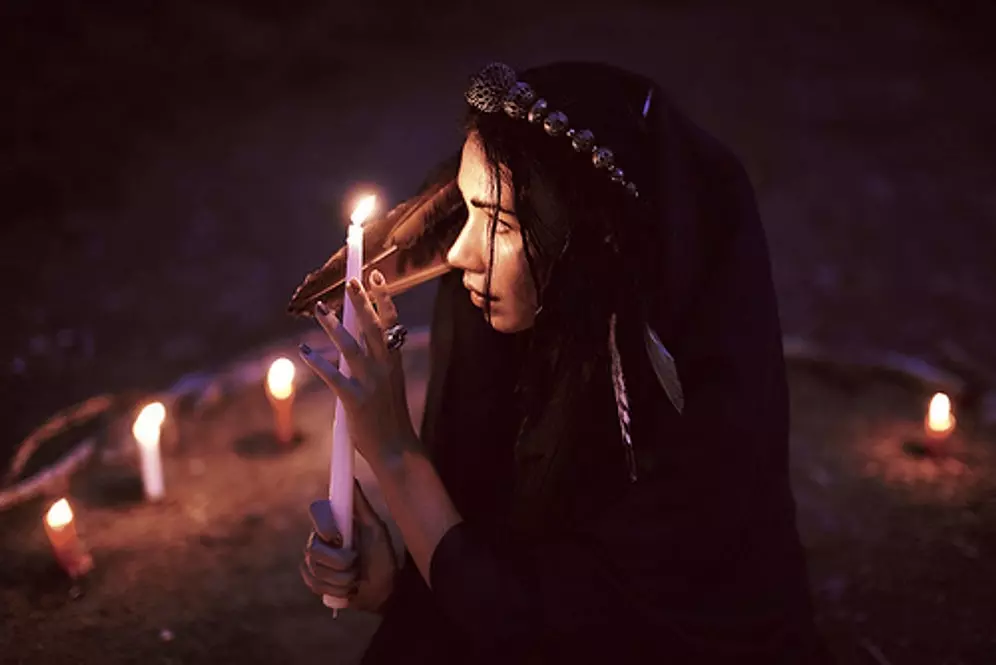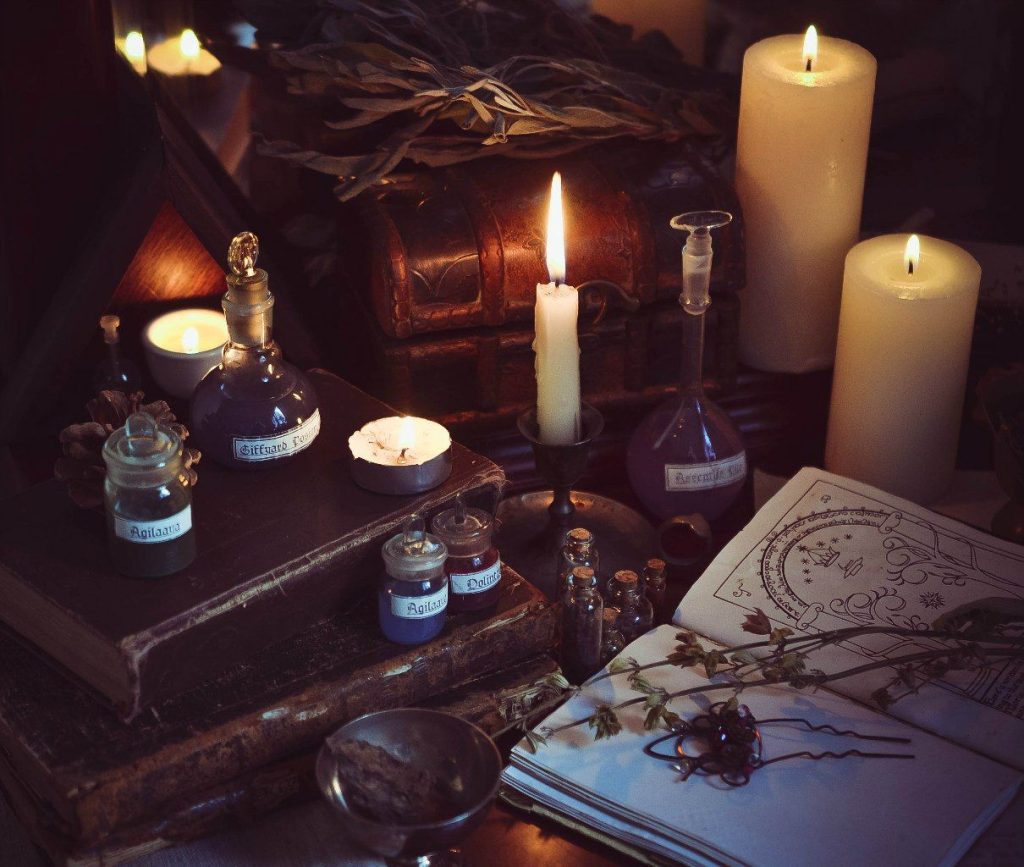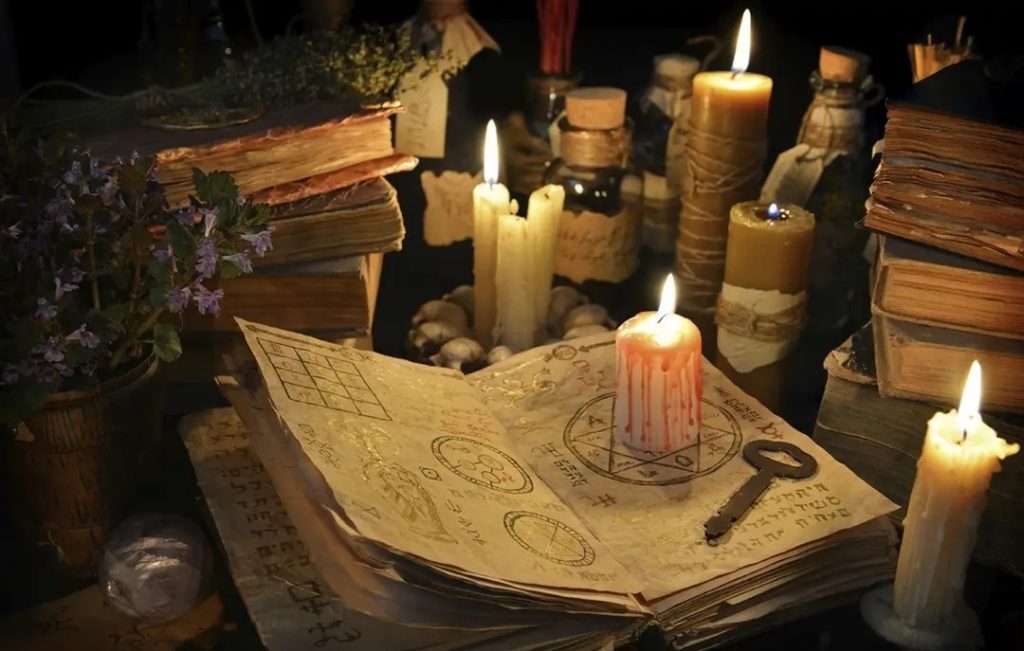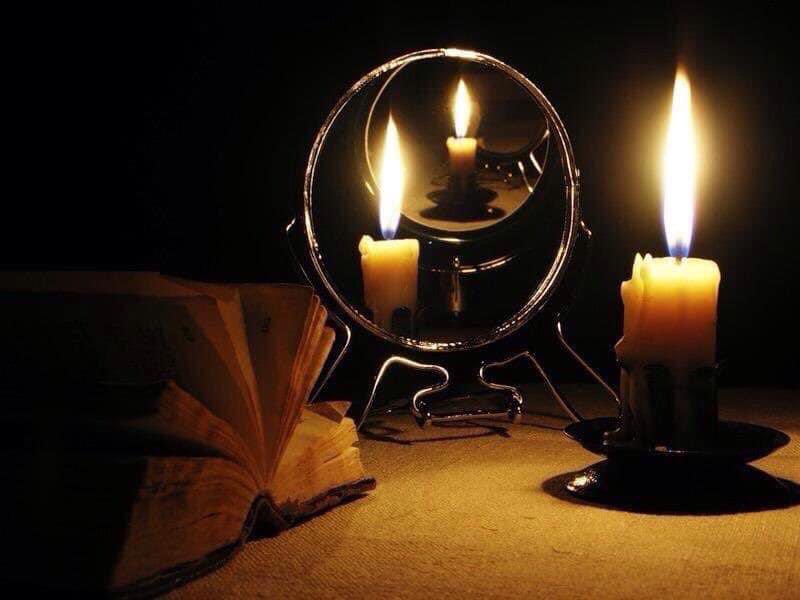Among the myriad types of candles, ritual candles hold a special place even in witch symbols and Wiccan. These candles are more than just wax and wick; they are imbued with intention, symbolism, and a sense of the sacred. In this article, we will explore the fascinating world of ritual candles, their history, significance, and how they are used in various traditions and modern practices.
What are Ritual Candles?
What are ritual candles? Ritual candles, also known as chime candles, are an important tool for many witches, spell casters, and spiritualists. They tend to be narrower and shorter than taper candles. These candles can be used for a variety of purposes, such as spells, manifestations, witchcraft, spirituality, and altars. Additionally, ritual candles are widely used in religious and spiritual practices around the world, where their colors, scents, and symbolic significance hold great importance. They play a central role in creating a sacred atmosphere, focusing intentions, and facilitating various rituals and ceremonies.
A Brief History of Ritual Candles
The history of ritual candles is a fascinating journey through time, reflecting the profound significance of light in human culture and spirituality. Here’s a more in-depth exploration of their history:
- Ancient Civilizations: The use of candles in rituals and ceremonies can be traced back to ancient civilizations. One of the earliest recorded uses of candles dates to ancient Egypt, where they were used in religious ceremonies and tombs. The Egyptians believed that the light of the candle helped guide the soul in the afterlife.
- Greco-Roman Era: In ancient Greece and Rome, candles were an integral part of religious and cultural practices. The Greeks used candles as offerings to their gods, and the Romans incorporated candles into various festivals and religious rituals. Candles were also used in early Christian gatherings to symbolize Christ as the “Light of the World.”
- Middle Ages: The Middle Ages saw the widespread use of candles in religious settings, particularly in Christian monastic orders. Monks and nuns used candles during daily prayers and rituals, with each candle often representing a specific aspect of their faith. Candlelit processions and vigils became common during this period, emphasizing the spiritual significance of candlelight.
- Symbolism and Iconography: During the Middle Ages, candles began to take on specific colors, shapes, and scents, each with its own symbolism. For example, red candles were associated with love and passion, while white candles symbolized purity and holiness. This period also saw the development of candle iconography, where the shape of the candle held meaning. Taper candles, with their gradual, pointed shape, were often used for focused intention work, while figure candles, shaped like saints, deities, or symbols, represented specific energies or deities.
- Colonial America: Candle-making was a crucial skill in colonial America, where candles were primarily made from tallow (animal fat) or beeswax. These candles provided essential illumination in a time when electricity was nonexistent. The candlelit ambiance of early American homes was the backdrop for many rituals, celebrations, and gatherings.
- Industrial Revolution: The 19th century saw significant developments in candle production. The invention of stearin and paraffin wax greatly improved the quality of candles, making them more accessible and affordable. This period marked the transition from candles as a necessity for light to candles as a symbol of spirituality, celebration, and personal expression.
- Modern Usage: In contemporary times, ritual candles have transcended their religious and historical roots. They are embraced by a wide range of spiritual and personal development practices, as mentioned in the previous article section. Their symbolism, colors, and scents continue to play a vital role in intention setting, meditation, celebrations, and various forms of energy work.
Ritual candles have come a long way from their humble origins as a source of illumination. They have evolved into powerful tools for self-reflection, intention manifestation, and spiritual exploration. Regardless of one’s beliefs or traditions, the history of ritual candles serves as a testament to the enduring human fascination with the power of light and the symbolic significance we attribute to it.


What do candles symbolize?
The symbolism of ritual candles is a key aspect of their use in various traditions and practices. Each element of a ritual candle, including its color, scent, shape, and even the way it is lit, is carefully chosen to enhance the intention behind the ritual. Here’s a more detailed exploration of the symbolism associated with ritual candles:
Color: The color of a ritual candle is one of the most significant aspects of its symbolism. Different colors are associated with specific intentions or purposes, making color selection a crucial part of the ritual. Here are some common color associations:
- Red: Symbolizes love, passion, courage, and strength. Red candles are often used in rituals related to matters of the heart and personal power.
- Green: Represents growth, abundance, prosperity, and fertility. Green candles are used in rituals aimed at attracting wealth, financial success, and harmony in nature.
- Blue: Symbolizes tranquility, communication, healing, and spirituality. Blue candles are often used for meditation, communication with the divine, and promoting peace.
- White: Signifies purity, protection, clarity, and spiritual enlightenment. White candles are commonly used for purification, cleansing, and invoking higher guidance.
- Yellow: Represents intellect, creativity, clarity, and inspiration. Yellow candles are used in rituals that involve mental clarity, focus, and creativity.
- Purple: Symbolizes spiritual growth, intuition, and connection to the higher self. Purple candles are often used in rituals related to psychic abilities, meditation, and spiritual awakening.
- Pink: Signifies love, friendship, and affection. Pink candles are used in rituals related to self-love, self-care, and nurturing relationships.
- Black: Represents protection, banishing negativity, and transformation. Black candles are used to ward off negative energy, break bad habits, and facilitate change.
Scent: Scented candles are used to evoke specific emotions or energies. The choice of scent can enhance the overall intention of the ritual. For instance:
- Lavender: Promotes relaxation, healing, and calmness.
- Frankincense and Myrrh: Used for purification, spirituality, and connecting with the divine.
- Sandalwood: Enhances meditation, focus, and spiritual awareness.
- Citrus scents (e.g., orange, lemon): Bring a sense of positivity, energy, and vitality.
Shape: The shape of a ritual candle can also carry symbolism. Taper candles are often used for focused intention work due to their gradual and pointed shape, while figure candles, such as those shaped like deities, animals, or symbols, represent specific energies or deities relevant to the ritual.
Timing: The time at which a candle is lit can add an additional layer of symbolism to a ritual. Lighting a candle at sunrise may symbolize new beginnings and illumination, while lighting one at sunset can represent closure, release, or reflection.
Direction: In some traditions, the direction in which a candle is lit or placed may be significant. For example, lighting a candle in the east may symbolize the dawn of a new day or the start of a new project, while the west might represent the completion of a cycle or letting go of the past.
Understanding the symbolism of ritual candles allows practitioners to align their intentions with the energies associated with specific colors, scents, shapes, and timing. This thoughtful selection of candles enhances the power and effectiveness of various rituals, making them a potent tool for personal and spiritual growth.
Modern Uses of Ritual Candles
Modern uses of ritual candles have evolved beyond their traditional religious and spiritual contexts. Today, ritual candles are embraced by a diverse range of people seeking personal growth, mindfulness, intention setting, and spiritual exploration. Here’s a deeper look at some of the contemporary applications of ritual candles:
- Meditation and Mindfulness: Many individuals incorporate ritual candles into their meditation and mindfulness practices. Lighting a candle can serve as a focal point, helping to calm the mind and create a serene atmosphere. Observing the flickering flame can enhance concentration and promote a sense of peace and relaxation.
- Intention Setting and Manifestation: Ritual candles are often used for setting intentions and manifesting desires. Practitioners may write down specific goals, desires, or affirmations and then burn these notes alongside a candle. The act of burning symbolizes releasing intentions into the universe, and the candle’s energy is believed to amplify the intention.
- Celebrations and Rituals: Ritual candles continue to be an integral part of various celebrations and rituals, including birthdays, weddings, and religious ceremonies. Lighting candles during these occasions symbolizes joy, unity, and the sacredness of the moment. Candles can also be used to commemorate loved ones during memorial services and remembrance ceremonies.
- Healing and Energy Work: In alternative healing practices like Reiki, energy healing, and chakra balancing, ritual candles are sometimes used to facilitate the flow of energy. Practitioners may place candles strategically around the recipient or use them to cleanse and purify the energy in a space.
- Spiritual Exploration: Many people use ritual candles as tools for spiritual exploration and connection. Whether in solitary rituals or group ceremonies, candles are employed to invoke specific energies, deities, or archetypes. Some may use candles to explore their own spirituality, conduct rituals based on their personal beliefs, or engage in eclectic spiritual practices.
- Aromatherapy and Scented Candles: Scented ritual candles have gained popularity for their aromatherapeutic benefits. Aromatherapy candles often feature essential oils and fragrances that can promote relaxation, stress relief, and emotional balance. Lighting scented candles can create a sensory experience that complements various practices, such as yoga, meditation, or self-care routines.
- Practical Applications: Beyond the spiritual and emotional aspects, ritual candles are also used for practical purposes. Emergency candles, citronella candles for repelling insects, and scented candles for ambiance are examples of how candles serve everyday functions while still carrying symbolic meaning.
- Personal Growth and Self-Care: Lighting a candle as part of a self-care routine can be a simple yet powerful act. It can symbolize self-love, self-reflection, and the commitment to one’s personal growth and well-being. Taking a moment to connect with the candle’s energy can be a form of self-empowerment.
- Environmental and Sustainable Candles: With growing environmental awareness, some individuals opt for eco-friendly and sustainable candles made from natural materials like soy or beeswax. These candles align with their values of conscious consumerism and respect for the planet.
In the modern era, ritual candles have become versatile tools for enhancing various aspects of life, from spiritual practices to personal development and self-care. Their adaptability and symbolism continue to resonate with people seeking meaningful ways to connect with their intentions, emotions, and inner selves. Whether used in traditional rituals or contemporary contexts, ritual candles remain a source of light, inspiration, and transformation.


The Ritualistic Use of Candles
In spiritual and magical practices, candles are often incorporated into rituals to amplify intention, focus energy, and create a sacred ambiance. Here are some common ways candles are used:
- Setting the Intention: Before lighting a ritual candle, practitioners often imbue it with their intention, focusing their thoughts and desires into the flame. This act helps to clarify purpose and direct energy towards a specific goal.
- Candle Lighting Rituals: Lighting candles in specific sequences or arrangements is a common practice in many traditions. For example, in Wiccan rituals, practitioners may light candles to represent the four elements—earth, air, fire, and water—creating a sacred space and invoking their energies.
- Candle Magic: Candle magic involves using candles as a focal point for spellwork and manifestation. By inscribing symbols, words, or names on the candles and infusing them with intention, practitioners harness the candle’s energy to bring about desired outcomes.
- Meditation and Contemplation: Candles can serve as objects of focus during meditation or contemplative practices. The soft, flickering flame can help calm the mind and deepen concentration, facilitating spiritual connection and inner reflection.
- Ritual Ceremonies: Candles often play a central role in various ceremonial practices, such as religious rituals, initiations, and rites of passage. They symbolize the presence of the divine, marking sacred space and time.
Tips and Guidelines to Consider When Using Ritual Candles
- Set Clear Intentions: Before engaging in candle magic, take the time to clearly define your intention. Be specific about what you want to manifest or achieve through your ritual. The clarity of your intention will help focus your energy and enhance the effectiveness of the practice.
- Choose the Right Candle: Select a candle that aligns with your intention and the symbolism associated with your desired outcome. Consider the color, shape, and size of the candle. You may also choose to anoint or decorate the candle with oils, herbs, or symbols that correspond to your intention.
- Cleanse and Charge the Candle: Before using a ritual candle for magic, it’s beneficial to cleanse and charge it with your energy. You can do this by holding the candle in your hands, visualizing it being cleansed of any previous energy, and infusing it with your intention and personal energy.
- Create a Sacred Space: Set up a dedicated space for your candle magic practice. Clear the area of clutter and distractions. You may choose to cleanse the space with incense, smudging, or other purification methods to create a sacred and energetically conducive environment.
- Focus and Visualization: Before lighting the candle, take a few moments to center yourself and focus your mind. Visualize your intention clearly, imagining the desired outcome as if it has already manifested. Hold this visualization as you light the candle.
- Speak or Write Affirmations: Use affirmations or incantations that reinforce your intention. You can speak them out loud or write them down on a piece of paper. Repeat the affirmations with conviction and belief, infusing them with the energy of your intention.
- Candle Lighting Ritual: As you light the candle, be mindful of the symbolism of the flame. Imagine that the flame represents the energy and power of your intention. You may choose to recite a prayer, chant, or invocation to further amplify your intention.
- Candle Gazing or Meditation: Sit in front of the lit candle and allow your gaze to soften as you focus on the flame. Alternatively, you can close your eyes and visualize the flame in your mind’s eye. Use this time for meditation, connecting with the energy of the candle, and reinforcing your intention.
- Allow the Candle to Burn: Let the candle burn completely, if possible, as it symbolizes the continuous energy and commitment toward your intention. If you need to extinguish the candle, use a candle snuffer or gently blow it out, stating your gratitude and intention to continue the work.
- Practice Gratitude: After the candle has burned, express gratitude for the energy and assistance provided by the ritual. Acknowledge and trust that your intention has been set in motion and release it to the universe, knowing that the work has been done.
Remember, candle magic is a personal and intuitive practice. Feel free to adapt these guidelines to suit your own beliefs and preferences. Trust your instincts, follow your intuition, and experiment with different techniques to find what resonates best with you.


Why are Candles important in Rituals?
Why are Candles important in Rituals? Candles hold great importance in rituals due to their rich symbolism and multifaceted roles. They are often used as potent symbols, representing elements like fire, which signifies transformation and purification. Additionally, candles aid in concentration and focus during rituals, helping participants channel their thoughts and intentions. The act of lighting a candle serves as a tangible and mental trigger, marking the beginning of a sacred or meditative space.
The warm, gentle glow of candlelight contributes to the creation of a reverent atmosphere, fostering a deeper connection to the divine or the spiritual realm. Furthermore, candles are frequently employed to invoke specific energies, entities, or intentions, making them an integral tool in various religious, spiritual, and mystical practices across cultures and traditions.
Certainly, here are some common reasons why candles play a crucial role in rituals:
- Symbolism: Candles are rich in symbolism, often representing elements like fire, which symbolizes transformation, purification, and the spiritual realm. Different candle colors and shapes may symbolize specific intentions or aspects of the ritual.
- Focus and Concentration: Lighting a candle can help participants in a ritual focus their thoughts, energy, and intentions on the task at hand. The act of lighting a candle can serve as a physical and mental cue to enter a sacred or meditative space.
- Sacred Space: Candles are often used to delineate a sacred or ritual space. The soft, warm glow of candlelight creates an ambiance that fosters a sense of reverence and connection to the divine or spiritual forces.
- Invocation: In many traditions, candles are used to invoke deities, energies, or specific intentions. The candle flame is believed to serve as a beacon to attract or communicate with these higher powers or energies.
- Practical Illumination: In some cases, candles provide practical illumination during rituals held in dimly lit or outdoor settings. They not only serve a spiritual purpose but also ensure that participants can see and perform their rituals effectively.
- Timekeeping: Candles can also be used to measure the passage of time during a ritual, especially in ceremonies that require specific durations or phases.
- Aesthetic and Atmosphere: The aesthetics of candles, along with their gentle flickering light, contribute to the overall atmosphere of a ritual. They create a serene and contemplative environment that enhances the spiritual or ceremonial experience.
- Tradition and Continuity: Many rituals have been passed down through generations, and candles are often part of these long-standing traditions. Using candles maintains a sense of continuity and connection to ancestral practices.
These reasons, among others, demonstrate the multifaceted roles that candles play in rituals across various cultures, belief systems, and spiritual practices.
Recommended Books on Ritual Candles
There are several books that delve into the topic of ritual candles, covering their history, symbolism, and practical use in various spiritual and magical traditions. Here are some recommended books on ritual candles:
- “The Complete Candlemaker: Techniques, Projects, and Inspirations” by Norma Coney. This comprehensive guide not only covers the art of candle making but also delves into the symbolism and significance of candles in various rituals and ceremonies.
- “The Candle Magic Workbook: Why and How Candle Magic Works” by Kala Trobe. This book explores the theory and practice of candle magic, providing a deeper understanding of how and why candle magic is effective. It includes practical exercises and rituals.
- “Candle Magic for Beginners: The Simplest Magic You Can Do” by Richard Webster. Geared towards beginners, this book offers a step-by-step guide to candle magic, including choosing the right candles, setting intentions, and conducting basic rituals.
- “The Modern Witchcraft Spell Book: Your Complete Guide to Crafting and Casting Spells” by Skye Alexander. While not solely focused on candles, this book includes sections on candle magic, explaining its role in modern witchcraft and offering a variety of spells and rituals.
- “The Witch’s Book of Shadows: The Craft, Lore & Magick of the Witch’s Grimoire” by Phyllis Curott. Phyllis Curott explores various aspects of witchcraft in this book, including candle magic. She provides insights into the symbolism of candles and their use in spellwork.
- “Candle Magic: A Witch’s Guide to Spells and Rituals” by Patricia Telesco. Patricia Telesco offers a comprehensive guide to candle magic, covering everything from choosing the right candles to crafting rituals for different intentions.
These books offer a wealth of knowledge on the subject of ritual candles, catering to both beginners and more experienced practitioners who want to deepen their understanding of candle magic and its various applications in spirituality and magic.
Conclusion
Ritual candles have a long and rich history, spanning numerous cultures and traditions. They hold a special place in the hearts of those who use them, whether for religious purposes, personal growth, or spiritual exploration. The symbolism and intention behind each candle add depth and meaning to our daily lives, connecting us to the ancient traditions that have illuminated the human spirit for millennia. So, the next time you light a candle, take a moment to reflect on the intention behind it and the ancient wisdom it carries.


Pingback: The Magic of Ritual Candles: Illuminating Tradi...